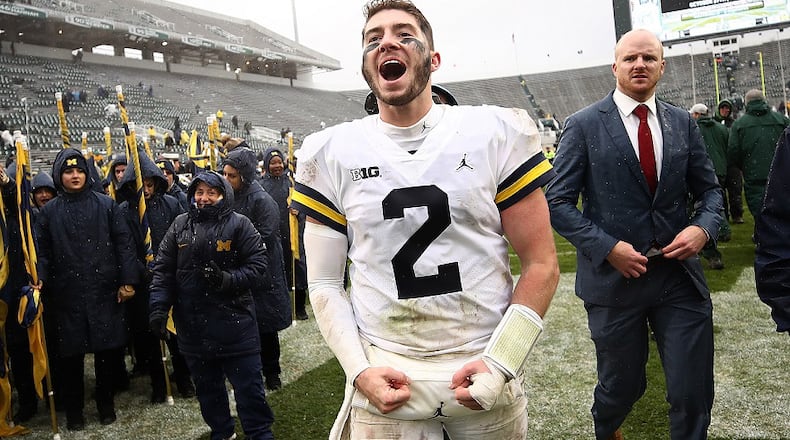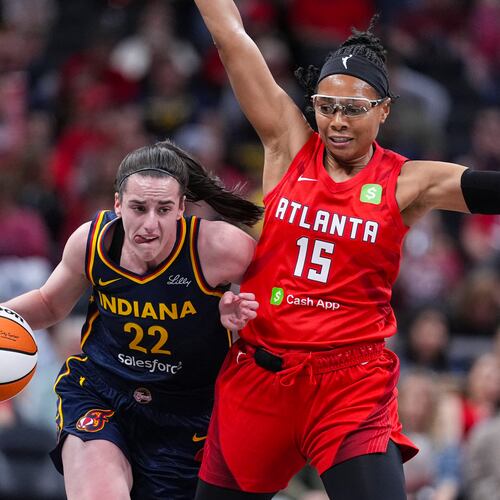The greatest decision that quarterback Shea Patterson said he’s made on his own is transferring to Michigan.
Patterson, a quarterback for Ole Miss from 2016-17, transferred to Michigan in December 2017 in wake of Ole Miss’ self-imposed postseason ban resulting from an NCAA investigation that uncovered several violations and controversy surrounding former coach Hugh Freeze.
Even with the drama and adjustment that goes along with a transfer, Patterson’s decision to transfer from Ole Miss in 2017 has resulted in the opportunity to lead a talented team to the postseason and experience a bowl game for the first time in his collegiate career.
In the midst of preparations for Saturday’s Chick-fil-A Peach Bowl game against Florida, Patterson added to the excitement of playing in a New Year’s Six Bowl by announcing he would return to Michigan for his senior season — a decision he said he made long before last weekend’s announcement.
“Just being at Michigan, it’s a special place,” Patterson said of why he chose to return. “Just being here with these guys and just a really good team full of good dudes and just getting a taste of a full season with guys I really like.”
Patterson’s decision to stay at Michigan for his senior season was greatly influenced by this being his first full season playing collegiate football. In 2016, Ole Miss coaches intended to redshirt Patterson, but an injury to starter Chad Kelly forced them to play Patterson and start the remaining three games of the season. In 2017, Patterson started at quarterback, but played in only seven games before he sustained a season-ending knee injury against LSU.
Patterson, a graduate of IMG Academy in Bradenton, Fla., recovered from that knee injury and recorded 2,364 passing yards, 21 touchdowns, five interceptions and a career-high completion percentage of 64.8 percent in his first season with Michigan.
“He’s been great at getting better at everything,” Michigan coach Jim Harbaugh said earlier this week. “He's an ascending player. It's just everything you ask him to do, he's got the athletic ability to go out and do it. He's really serious about being good. He's so focused at practice and he's the type of player that you can give a coaching point to and he gets it and practices and improves on it.”
Patterson’s seriousness “about being good” can easily be seen in how his presence has improved Michigan’s offense since his arrival.
Michigan is on the cusp of an 11-win season after an 8-5 record last season. Having Patterson under center has enhanced Michigan’s passing game and execution in the red zone. Michigan has averaged 11 more points and 41.6 more passing yards per game as well as 14 more passing touchdowns on the season. The Wolverines also increased their number of red-zone trips from 44 to 55 and scored on 11 more possessions inside the red zone than they did last season.
But Patterson’s arm isn’t the main focus for Florida’s defense — his legs are.
After watching video and breaking down Patterson’s tendencies, Florida’s defense knows limiting him will be a large part of the challenge it faces Saturday.
“Anytime there’s 11 guys out there and all 11 can run, it’s much better when that one guy out there has to play static,” Florida defensive coordinator Todd Grantham said. “What happens is in the run game, if he’s not a threat, then it’s really 11 guys on 10 because you really don’t have to account for the guy. In the pass game, you can collapse the pocket and he can’t extend plays with his feet and a guy that’s athletic like that can extend plays and buy time for guys to get open down the field.”
This season, Patterson rushed for 268 yards and two touchdowns this season, averaging 4.1 yards per carry.
“Shea Patterson’s going to take off. He’s going to run,” Florida defensive lineman Cece Jefferson said. “We just have to do a good job of making sure we can set the edge and contain him, making him play just quarterback, not running back and quarterback.”
Although Saturday will be the first time the former SEC quarterback will face the Gators’ defense, Patterson has faced Florida coach Dan Mullen before, in 2016 when Mullen coached at Mississippi State.
“I’ve faced him before, I don’t know if that is good or bad, when he was quarterback at Ole Miss,” Mullen said this week. “He's a very talented quarterback, has a great arm, makes reads, stays in the pocket and delivers the ball, but the thing to me that really makes him even more difficult to defend is when he starts to improvise. ... Where he drops back, you get a good rush and we have the route covered and now he takes off and starts making things happen, and that is one of the things that makes him very difficult to defend.”
The 2018 Chick-fil-A Peach Bowl kicks off Saturday at noon and can be watched on ESPN.
About the Author
Keep Reading
The Latest
Featured


